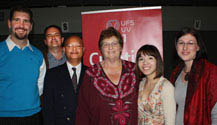 |
At the lecture were, from the left: Dr Arno van Niekerk (Department of Economy), Dr Francois Strydom (Centre for Teaching and Learning), Dr Mallory du Plooy (UFS101), Ms Gill Marcus, Governor of the Reserve Bank, and Lauren Hing and Louise Strydom of the UFS101 office.
Photo: Leatitia Pienaar.
6 September 2012 |
The global financial crisis the world has been experiencing since 2008 is far from over. In fact, Gill Marcus, Governor of the South African Reserve Bank, expects it to last for the next five years. “It is the longest financial crisis in history,” she said.
Ms Marcus lectured in the new UFS101 course of the university. The course was implemented at the beginning of the year and is aimed at broadening the world for new first-year students. About 2 000 students are taking the course.
Ms Marcus brought globalisation home and explained how activities in the international area impact on the lives of South Africans. She said South Africa was not excluded from the effect of global crises. Ms Marcus also said that South Africa was one of only a few countries in the world not experiencing a banking crisis due to strict controls in place, but more could be done.
“The big question is how to make sure that the South African banking system stays sound,” she said.
On a question about the debt of South Africans, she said it was important for South Africans to live within their means. “If we want to afford our new development, we need a savings percentage of 25 percent.” South Africa needs foreign capital investment to supplement the low local savings.
“It is difficult to resist all aspects of globalisation. Some can be to our advantage, but the others pose tremendous challenges.”